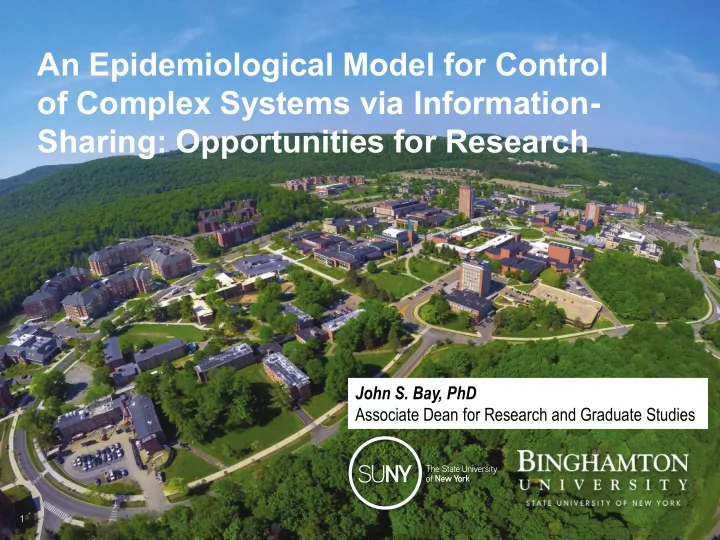

An Epidemiological Model for Control of Complex Systems via Information- Sharing: Opportunities for Research John S. Bay, PhD Associate Dean for Research and Graduate Studies 1
2 T H O M A S J . W A T S O N S C H O O L O F E N G I N E E R I N G A N D A P P L I E D S C I E N C E | My Introduction to Complex Systems: 1990 The “Army Ant” Robot Concept • Coordinated control through anonymous mechanical coupling • Autonomous recruitment and collaboration • No supervisory level • Only broadcast communications • Complex dynamics in both the physical and behavioral domains
4 In the News
5 The Problem: Cybersecurity for Healthcare Records • Data breaches in the health care industry have exposed the largest number of personal records of New Yorkers since 2006. • Healthcare records are a primary target of malicious hackers • Each personal compromised record costs an entity approximately $363 - Much more than any other type of record Many institutions and providers have no in-house security capabilities or resources
6 T H O M A S J . W A T S O N S C H O O L O F E N G I N E E R I N G A N D A P P L I E D S C I E N C E | The Idea: Create a Security Cooperative • Create a social response • Use shared capabilities and services • How would this work?? Compare to epidemiology
7 Ebola. 1976, Zaire Ebola Not as virulently infectious; most deadly
8 Legionnaire’s Disease. 1976, Philadelphia More virulently infectious; less deadly
9 SARS. Hong Kong 2003 Most virulently infectious; not as deadly
10 Extending an Epidemiology Model to Cybersecurity Timothy Kelly and L. Jean Camp, “Online Promiscuity: Prophylactic Patching and the Spread of Computer Transmitted Infections,” Workshop on the Economics of Information Security (WEIS) 2012, June 25-26, Berlin, Germany.
11 Modeling the Spread of Infection What are the key variables? • Transmissibility • Contact • Preventative Measures - Costs to protect - Social response • Elapsed Time • Vigilance • Recovery Rate
12 The Translation to Malware Some Conclusions are Common to Both Healthcare and Malware • “Risk Communication” is more effective than “Global Mandates” for actions • Central reporting and incident response is important to containing the event • Small groups of users engaging in risky behavior are a threat to the entire population • Spread of infection can be arrested by - Immunization - Treatment (patching) - Awareness & active vigilance - Central reporting: a CDC for Malware?
13 Health Incident Reporting is Mandatory Centers for Disease Control World Health Organization State Health Departments
14 But Cyber Incident Reporting is NOT Mandatory! What Is The Problem? • Privacy protections • Means of exchange • Civilian vs. military control • Limitations of use/disclosure • Information accountability • Monitoring authority • Countermeasure authority • Unfunded mandates Private entities are reluctant to share information that will be accessible to the • Liabilities government
15 Cyber Information Sharing: The Law US Congress Passes a Cybersecurity Sharing Bill … on the 13 th Attempt!
16 Cyber Information Sharing: The Communities Even specialized sharing organizations have emerged
17 T H O M A S J . W A T S O N S C H O O L O F E N G I N E E R I N G A N D A P P L I E D S C I E N C E | Now Reaching the Commercial Market The OLD Way: The NEW Way: • Define a file genome • Learn patterns in good files and in malware • Classification
18 Cybersecurity Law and Regulations • CISA: Cyber Information Sharing Act • Sector-Level Regulations (e.g. SEC, DoD, HHS) • Corporate Board responsibilities • Legal rulings • Insurance Matters • NY Data Security Act
19 … and in Public Policy [ Workshop on the Economics of Information Security (WEIS) 2012, June 25-26, Berlin, Germany.]
20 Doing the Math … • Security information sharing is almost always a good "social" policy, and can be shown to benefit companies individually as well – even competitors. • Reporting policies are most effective in conjunction with - low "disclosure costs" (costs to report and remediate), - highly-effective "detective controls" (companies must have effective means to detect intrusions, or else they are unfairly punished for missing them) - highly effective dissemination of knowledge from the informed authority, and - firms that have a high degree of "security interdependence" (a breach in one company increases the probability of a breach at another company) • Any effective policy will include a significant -- but not excessive -- probability of audit. Without this, even large sanctions/penalties will not increase the level of compliance
21 T H O M A S J . W A T S O N S C H O O L O F E N G I N E E R I N G A N D A P P L I E D S C I E N C E | Opportunities Business is good And there are a lot of open questions: o Generalization to generic “optimal policy” for government o How to model and incorporate privacy
22 Awareness, Vigilance, Susceptibility
Recommend
More recommend